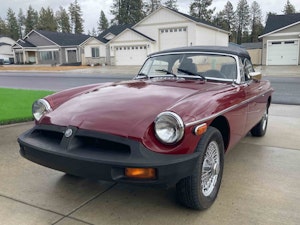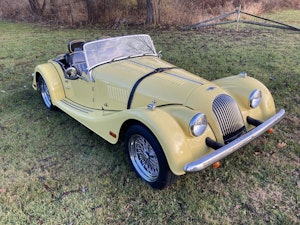Media | Articles
Final Parking Space: 1980 Mercury Zephyr Z-7 Turbocharged Sports Coupe
When it comes to the Ford Fox Body, the Mustang Foxes have generally received most of the enthusiast attention. There were plenty of other performance-oriented members of the Fox Family built during the platform’s 1978-1993 reign, though, and today we’re going to take a look at one of the rarest of them all: Mercury’s one-model-year-only turbocharged Zephyr coupe, found in the same Denver-area self-service car graveyard that brought us last week’s 1954 Dodge Meadowbrook.

Before you Box Fox fanatics begin crazed 120-mph runs in tool-stuffed Fairmont wagons on the quickest possible road to the Centennial State, I’m going to give you the bad news right now: this car got stripped of its front body components and most of its interior within a day— maybe it was hours— of my initial photo session.

Now we’ll have a bit of Zephyr history. Ford developed the Fox platform to replace the chassis family that began life under the 1960 Falcon, and it debuted with the 1978 Ford Fairmont and its Mercurized twin, the Zephyr (the Fox Mustang/Capri had to wait until 1979).

The new Foxes were lighter, nimbler and more fuel-efficient than their predecessors, and sales were strong right off the bat. Fairmont shoppers looking for something a little more rakish could skip the sensible sedans and wagons and get behind the wheel of a snazzy new coupe version, badged as the Futura.

Because nearly every Ford model at that time required a Mercury doppelgänger, Mercury got its own version known as the Zephyr Z-7.
Marketplace
Buy and sell classics with confidence

The build tag tells us that this car was born at the Mahwah Assembly plant in New Jersey, about nine months before the factory was shut down forever (I shot a Mahwah-built ’64 Mercury Montclair at a Denver junkyard about a year ago). The DSO code of 51 indicates that it was sold out of Ford’s Denver office.

The Zephyr name goes way back in Ford Motor Company history. Lincoln first used the name on 1936 models, followed by Ford of Britain from 1950 through 1972 (and the Ford Zephyr was available in left-hand-drive form in the United States). The Mercury Zephyr was sold through 1983, after which it was replaced by the Topaz. Later on, there was the one-year-only 2006 Lincoln Zephyr (which became the MKZ) and it looked for a while as though Changan Ford would be building Lincoln Zephyr Reflections in China (that car was launched as the Lincoln Z).

The 1980 Zephyr was available with a choice of four different engines: the base 2.3-liter “Pinto” SOHC straight-four, the ancient 200-cubic-inch Thriftpower pushrod straight-six that first saw service in 1964 Falcons, a 255-cubic-inch version of the good old Windsor pushrod V-8, and a turbocharged 2.3.

This car got the turbocharged engine, rated at 120 horsepower and 145 pound-feet.

The 255 V-8 made 119 horses, but its torque was stronger at 194 pound-feet. The Thriftpower generated 91 horsepower and 160 pound-feet, while the naturally-aspirated base 2.3 was good for 88 hp and 118 pound-feet. This car had a curb weight of just 2644 pounds (just a couple hundred pounds more than a 2025 Mazda Miata, to put things in perspective), so it was respectably quick with the turbo motor.

This engine uses a draw-through design with no intercooler, with the turbocharger inhaling the fuel-air mix through a two-barrel carburetor. Turbocharged engines didn’t really become suitable for hassle-free everyday driving until the advent of electronic fuel injection in affordable cars, later in the decade.

The special hood scoop was gone when I arrived the first time.

The carbureted 2.3-liter turbo engine was available in the Fox Mustang and Capri through 1981, but it was a 1980-only option for the Fairmont and Zephyr. Later in the decade, turbocharged 2.3s equipped with modern EFI made real power in the SVO Mustang, Thunderbird Turbo Coupe, and Merkur XR4ti.

The Z7’s interior was Detroit Malaise Era personal luxury coupe all the way. This car even has the optional sunroof.

Here’s what it looked like a day later.

You had to get the automatic transmission with the turbocharged engine, sadly.

The original owner’s manual was still inside.

This note inside the manual indicates that this car was bought or at least serviced at Johnny Haas Lincoln-Mercury on West Colfax in Lakewood (just west of Denver). You could buy a new English Ford at Johnny Haas during the 1960s.

The keys were still in it at the end.
Put fire in your life with a Z-7!




















































































































































Cool car- almost bought a used Fairmont verson of that model with the same drivetrain
I didn’t realize a turbo option was available on these things. This would not have exactly caught my radar as a kid.
These and the LTDs were the ultimate sleeper cars back in the day
About all that could be expected from an American car during the malaise era. Is it any wonder anyone of means in the designer jeans years usually bought a Porsche, a BMW or Mercedes?!
The thing about the Malaise era is it didn’t take too much tinkering to unleash the choked off horses… of course to your comment, this probably wasn’t something the designer jean set was doing a lot of
As complete as this car was when first dropped in the yard, and the condition it shows to be in, it was probably in a garage of an estate that went to probate, or the heirs were out-of-state and wanted nothing but $$ from the house. it wouldn’t surprise me if this car would start & (kinda) run what with a battery & oil change…ok, maybe tires, tune-up, etc
I agree, I am surprised someone didn’t just buy the whole car right away instead of people picking through it for parts right away. This car was definitely complete and decent and quite unique. It should have been saved.
Sajeev is going to be heartbroken when he sees this
Phil actually texted this vehicle to me before he wrote about it. I’ve been heartbroken ever since!
Phil, the commentary on “Box Fox fanatics” was probably the funniest thing I’ve read in years. I knew a lot of both Saab and Volvo crazies in my 20s, back around the Y2K era. I remember one Sat morning when the distinctive sound of an open down pipe turbo red block whistled into my driveway. Said Ivan:
“Grab your toolbox. It’s a flat hood 242 GLT, it’s in Cedar City, Utah, and we need to get up there RIGHT NOW.”
The fanatics, whatever the make, are lurking out there. Thanks for proving that the Turbo Fairmont/Zephyr actually was built. My FiL who had a 2.3 Fairmont company car in that era insists it was like the 455 Super Duty Grand Am… in the brochures, never made it to the showroom. Nope, they built at least one.
Learned something new today: 70s/80s Fox body sedans and coupes are apparently much more popular than I thought if one is stripped in a day like vultures on a road squirrel.
Another could of ,would of ,should of Bob Glidden pro stock clone bites the dust.
I had a ’79 Zephyr (ES Trim – very European) with a 302 and 4 speed manual as a company car driving around Detroit. Was a blast to drive and fast.
I tried to like these but never did. I do recall seeing a new turbo Fairmont Futura at a Ford dealer back in the day.
I had this motor in a 79 Mustang Pace Car. If I’m being honest it was a bit of a dog, even by 80s standards. It was rated at 132 hp in the Mustang. That car at least had a 4 speed manual. This thing with the auto was probably not going anywhere in a hurry. Still, it was fun for my 17 year old self to hear that little turbo whistle and the “TURBO” dash light glow green. I was reminded of the lack of power once my best friend at the time got a new 84 Mustang GT.
I never drove the Mercury version, but my high school had the Ford Fairmont version for driver’s ed(non-turbo). Descent driver for DE, but couldn’t squeal the tires unless you had wet pavement. The 2nd half of driver’s ed we got a 4-speed Ford Granada to learn how to use the manual! Now, that was fun!
My high school also had a 4 cylinder non turbo Fairmont driver’s ed car in the early 80’s. Complete turd.
I sold Fords in 1978/79. Not a great selection. Fairmonts were ugly square boxes. The Mustang turbos were pieces of crap. Never saw a Zephyr turbo.
BUT…The best car back then was the 1979 Ford Fairmont Futura (a Zephyr with better tail lights) with a 302.
Fast, cool car with a great stereo system!
My Grandmother had a 2 tone brown 1978 Mercury Zephyr 4 door sedan, it was a great car and she drove it for quite a few years. It saved her in the accident when she got hit head on, a drunk driver ran into her. I’ll never forget that car, we had a lot of fun going places in that brown Mercury.